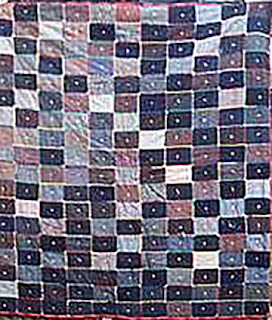Utilitarian bedcovers pieced of wool rectangles are one
of the very common styles we come across. They are not
glamorous or valuable but they are warm.
Relations to the far more popular crazy quilt, these show a
minimalism in color and repeat that has modern appeal.
1912
Many were made from wool rectangles and squares pulled off pages of sales samples.
They tend to be priced at about $50.
Although you can pay more if you want to.
I have quite a few dated examples. The earliest found so far is inscribed in embroidery 1895. That kind of surprised me as I expected they appeared in the '80s.
1895
You might not be inclined to describe this as a utilitarian
bedcover either.
1895
It looks like someone's long term embroidery project,
related to the fancy crazy quilts of the era, but not crazy
of random shaped pieced.
There seems to have been a fashion for fancy work
on wool in the mid '90s.
This 1896 example has a cut fringed border/edge.
1897 from Donna Vitale's inventory of Pennsylvania quilts.
This one, squares rather than rectangles, looks to be embroidered with wool yarn
& note the wool stars in the corners
Another red edge on the 1899 example
Then you start recognizing the florals.
A class? A teacher? A published pattern?
Undated example from Donna Vitale's inventory
Note red ruffle
1904 by C.D.K. in Virginia we can assume
1909, appliqued and embroidered
1910 from the Lebanon County, Pennsylvania project
1911
From the Texas project & the Quilt Index
1915, Nowata, Oklahoma Historical Society
I've many photos of similar embroidered quilts without dates. Looking at these
dated pieces we can guess the fashion was about 1895 to 1915.
1904
Something similar 20 years later.
1904
1910, Kalona, Iowa
1915
1915
The patchwork designs had names like Brickwork or Brickwall. Ruth Finley in 1929 called it Hit & Miss but she is referring more to the shading than the rectangle format.
This Oklahoma example dated 1918 was probably a fundraiser
for the Red Cross during World War I.
1924 Pope County, Minnesota Museum
1925
1898
I've found several examples with less embroidery
Sometimes just an identification and a date as in this Alabama example.
1912 with a little embroidered flourish in the corners
Another from 1912
1913. From the Ladies' Aid but the rest is mysterious.
West Virginia project & the Quilt Index
1915
Albert Smith is said to have made this while
sick in bed in West Virginia.
1915
Lena H. Moss from Iowa. The washable, light blue cotton strips
stitched over the edges protect the quilt from from grubby hands.
1916 by Mother
1916
World War I affected fabric availability in the teens and then new styles appeared in the late 1920s. However, a few examples in the 1930s show wool covers remained practical.1932, crib size
1939 R.M.
And here's the last, finished in 1954
1947-1954 Crib Size for H.H. perhaps
Progress?: Polyester fabrics replaced
wool for utilitarian bedding.
Dupont developed Dacron polyester in 1951.
Going back to the wool bedcovers. We have three styles which
we can make some rough guesses for dates:
- Wool patches with or without embroidery on the seams: 1890-1950
- Heavily embroidered wool patches: 1890-1930
- Wool name quilts: 1900-1930
Jeanne Poore's family quilt---ambiguous dates by
Grandma Enfield in the dedication block.
1897 or 1926.
Looking at these utility bedcovers we see an illustration of a truism about quilts and fabric. As an editor at Comfort magazine wrote about the time these quilts were being made
Patchwork is not the cutting up of whole cloth into bits for the sake of sewing it together again...but the utilizing of goods which is already cut up.
The fabric industry provides pre-cuts, as we call them today---quiltmakers respond with a style to incorporate those pieces.
1920
Post far afield:
http://barbarabrackman.blogspot.com/2015/09/man-rays-tapestry-readymade.html


.jpg)





























































I have one of these. Heavy and very warm. Right now it's draped over the back of the couch. The only downside - it got tossed in the washing machine and dryer and a few of the patches shrank more than the rest. Oh well - more character.
ReplyDeleteLove this post! I recall my grandmother had quilts of this type (made in Colorado 1910-1930). They were referred to as sougans and were a) beautiful in a somber way b) faintly smelling of camphor and c) very heavy. The fabrics were all very dark wool and the feather stitching was red. The corner junctions tied with red yarn. The backings were red flannel. It is possible the battings were old wool blankets.
ReplyDeleteThese were made for a family living in a soddie on the Colorado plains 1900-1934. Way too heavy for use nowadays but no doubt very good for the freezing plains winters.
Considering making one of my own but haven't come across any instructions that would tell me how to do it to avoid bulky seams and other issues. And also to make one that isn't too heavy!!
Thanks for this post!